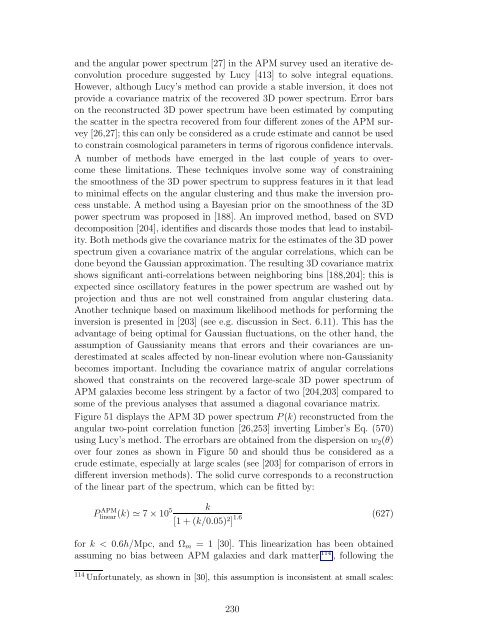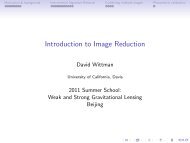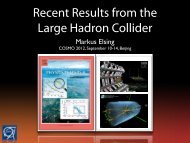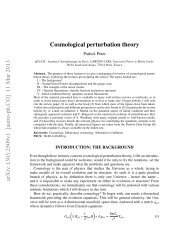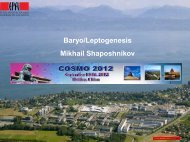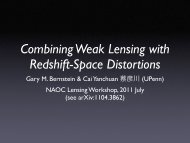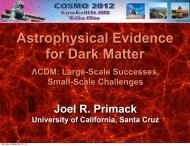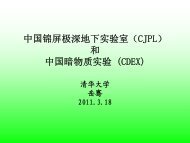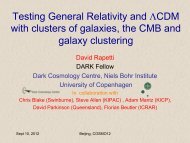Large-Scale Structure of the Universe and Cosmological ...
Large-Scale Structure of the Universe and Cosmological ...
Large-Scale Structure of the Universe and Cosmological ...
Create successful ePaper yourself
Turn your PDF publications into a flip-book with our unique Google optimized e-Paper software.
<strong>and</strong> <strong>the</strong> angular power spectrum [27] in <strong>the</strong> APM survey used an iterative deconvolution<br />
procedure suggested by Lucy [413] to solve integral equations.<br />
However, although Lucy’s method can provide a stable inversion, it does not<br />
provide a covariance matrix <strong>of</strong> <strong>the</strong> recovered 3D power spectrum. Error bars<br />
on <strong>the</strong> reconstructed 3D power spectrum have been estimated by computing<br />
<strong>the</strong> scatter in <strong>the</strong> spectra recovered from four different zones <strong>of</strong> <strong>the</strong> APM survey<br />
[26,27]; this can only be considered as a crude estimate <strong>and</strong> cannot be used<br />
to constrain cosmological parameters in terms <strong>of</strong> rigorous confidence intervals.<br />
A number <strong>of</strong> methods have emerged in <strong>the</strong> last couple <strong>of</strong> years to overcome<br />
<strong>the</strong>se limitations. These techniques involve some way <strong>of</strong> constraining<br />
<strong>the</strong> smoothness <strong>of</strong> <strong>the</strong> 3D power spectrum to suppress features in it that lead<br />
to minimal effects on <strong>the</strong> angular clustering <strong>and</strong> thus make <strong>the</strong> inversion process<br />
unstable. A method using a Bayesian prior on <strong>the</strong> smoothness <strong>of</strong> <strong>the</strong> 3D<br />
power spectrum was proposed in [188]. An improved method, based on SVD<br />
decomposition [204], identifies <strong>and</strong> discards those modes that lead to instability.<br />
Both methods give <strong>the</strong> covariance matrix for <strong>the</strong> estimates <strong>of</strong> <strong>the</strong> 3D power<br />
spectrum given a covariance matrix <strong>of</strong> <strong>the</strong> angular correlations, which can be<br />
done beyond <strong>the</strong> Gaussian approximation. The resulting 3D covariance matrix<br />
shows significant anti-correlations between neighboring bins [188,204]; this is<br />
expected since oscillatory features in <strong>the</strong> power spectrum are washed out by<br />
projection <strong>and</strong> thus are not well constrained from angular clustering data.<br />
Ano<strong>the</strong>r technique based on maximum likelihood methods for performing <strong>the</strong><br />
inversion is presented in [203] (see e.g. discussion in Sect. 6.11). This has <strong>the</strong><br />
advantage <strong>of</strong> being optimal for Gaussian fluctuations, on <strong>the</strong> o<strong>the</strong>r h<strong>and</strong>, <strong>the</strong><br />
assumption <strong>of</strong> Gaussianity means that errors <strong>and</strong> <strong>the</strong>ir covariances are underestimated<br />
at scales affected by non-linear evolution where non-Gaussianity<br />
becomes important. Including <strong>the</strong> covariance matrix <strong>of</strong> angular correlations<br />
showed that constraints on <strong>the</strong> recovered large-scale 3D power spectrum <strong>of</strong><br />
APM galaxies become less stringent by a factor <strong>of</strong> two [204,203] compared to<br />
some <strong>of</strong> <strong>the</strong> previous analyses that assumed a diagonal covariance matrix.<br />
Figure 51 displays <strong>the</strong> APM 3D power spectrum P(k) reconstructed from <strong>the</strong><br />
angular two-point correlation function [26,253] inverting Limber’s Eq. (570)<br />
using Lucy’s method. The errorbars are obtained from <strong>the</strong> dispersion on w2(θ)<br />
over four zones as shown in Figure 50 <strong>and</strong> should thus be considered as a<br />
crude estimate, especially at large scales (see [203] for comparison <strong>of</strong> errors in<br />
different inversion methods). The solid curve corresponds to a reconstruction<br />
<strong>of</strong> <strong>the</strong> linear part <strong>of</strong> <strong>the</strong> spectrum, which can be fitted by:<br />
P APM<br />
linear<br />
(k) ≃ 7 × 105<br />
k<br />
[1 + (k/0.05) 2 ] 1.6<br />
(627)<br />
for k < 0.6h/Mpc, <strong>and</strong> Ωm = 1 [30]. This linearization has been obtained<br />
assuming no bias between APM galaxies <strong>and</strong> dark matter 114 , following <strong>the</strong><br />
114 Unfortunately, as shown in [30], this assumption is inconsistent at small scales:<br />
230


